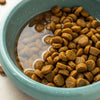How to Mix Dry and Wet Dog Food: A Complete Guide for Pet Parents
- Houndsy
Table of Contents
- Introduction
- Understanding Dry and Wet Dog Food
- The Benefits of Mixing Dry and Wet Dog Food
- How to Mix Dry and Wet Dog Food Effectively
- Potential Pitfalls to Avoid
- Real-Life Examples of Mixing Dry and Wet Dog Food
- Conclusion
Introduction
Did you know that a staggering 30% of dog owners report their pets being picky eaters? For many, mealtime can become a daily struggle filled with frustration and wasted food. If you find yourself in this situation, you’re not alone. As pet owners, we want to provide our beloved companions with a nutritious and enjoyable diet. One effective solution is mixing dry and wet dog food.
In this comprehensive guide, we’ll explore the benefits of combining these two food types, how to do it correctly, and what you need to consider when making the switch. By the end of this post, you’ll have a solid understanding of how to mix dry and wet dog food in a way that caters to your dog’s nutritional needs and satisfies their palate.
We’ll cover the benefits of both wet and dry dog food, practical tips for mixing them, and the potential pitfalls to watch out for. We’ll also share insightful anecdotes and examples that might resonate with your own experiences. So, let’s dive in and elevate your dog’s feeding routine together!
Understanding Dry and Wet Dog Food
Dry Dog Food: The Kibble King
Dry dog food, commonly known as kibble, has long been a staple in dog diets. Here are some key attributes:
- Convenience: Kibble is easy to store and measure, making it a favorite among busy pet owners. It has a long shelf life and doesn’t require refrigeration.
- Dental Health: Chewing on kibble can help reduce plaque build-up on your dog’s teeth, promoting dental health.
- Cost-Effectiveness: Generally, dry food is more affordable compared to wet alternatives, making it a budget-friendly option for many dog owners.
The majority of dry dog food contains around 10-12% moisture, which means it’s important to ensure your dog stays hydrated, especially if their diet consists primarily of kibble.
Wet Dog Food: The Moisture Marvel
On the other hand, wet dog food offers its own set of benefits:
- Enhanced Palatability: The enticing aroma and texture of wet food can make meals more appealing, especially for picky eaters or dogs with dental issues.
- Increased Hydration: With moisture content ranging from 75-78%, wet food can significantly contribute to your dog’s daily fluid intake, particularly important for dogs prone to urinary issues.
- Nutrient Density: Wet foods often contain higher protein and fat levels, making them suitable for dogs needing to gain or maintain weight.
While wet food can be more costly and requires proper storage once opened, its benefits often make it a worthwhile investment.
The Benefits of Mixing Dry and Wet Dog Food
Combining dry and wet dog food can provide a wealth of advantages, including:
1. Improved Taste and Variety
Mixing the two types can create a delightful meal that excites your dog’s taste buds. This variety helps keep mealtime interesting for dogs that may otherwise lose interest in their food.
2. Better Nutrition
By combining both types, you can offer a more balanced diet that incorporates the benefits of each. For instance, the crunchiness of kibble can promote dental health, while the added moisture from wet food can aid in hydration and digestion.
3. Customizable Feeding
Mixing allows you to tailor your dog’s meals based on their individual needs. Whether your dog needs to lose weight or gain muscle, you can adjust the ratio of dry to wet food accordingly.
4. Enhanced Hydration
As mentioned earlier, wet food contributes significantly to your dog’s hydration, which is crucial for overall health, especially for dogs with certain medical conditions.
5. Cost-Effectiveness
While wet food can be pricey, mixing it with dry food allows you to stretch the use of expensive wet food while still providing a flavorful meal.
How to Mix Dry and Wet Dog Food Effectively
Step 1: Consult Your Veterinarian
Before making any changes to your dog’s diet, it’s always wise to consult with your veterinarian. They can provide insights tailored to your dog’s specific health needs, age, and lifestyle.
Step 2: Start Slowly
When introducing mixed feeding, begin by gradually incorporating wet food into your dog’s dry food. A suggested starting ratio is 75% dry food to 25% wet food. This allows your dog to adjust to the new texture and flavor without overwhelming their digestive system.
Step 3: Measure Portions Carefully
Maintaining portion control is essential. Pay attention to the caloric content of both types of food, as wet food typically has fewer calories per gram compared to dry food. Adjust serving sizes accordingly to prevent overfeeding.
Step 4: Monitor Your Dog’s Reaction
Watch how your dog responds to the mixed food. Look for signs of satisfaction, such as eagerly finishing their meal or wagging their tail. Conversely, be on the lookout for any digestive issues or aversions to the new combination. Adjust the mix as needed based on their reactions.
Step 5: Maintain Freshness and Cleanliness
Ensure that both wet and dry food are stored properly to maintain freshness. For wet food, refrigerate any unused portions and consume them within a few days. Always provide fresh, clean water alongside meals to keep your dog hydrated.
Potential Pitfalls to Avoid
While mixing dry and wet dog food can be beneficial, there are a few common pitfalls to watch out for:
1. Nutritional Imbalance
Not all dog foods are created equal. Ensure that both the wet and dry food you choose are high-quality and nutritionally balanced. Look for products that meet AAFCO standards.
2. Spoilage and Waste
Wet food can spoil quickly if left out too long. To avoid waste, only serve what your dog can eat in one sitting. If your dog doesn’t finish their meal, remove any leftovers after 30 minutes.
3. Overfeeding
It’s easy to lose track of portion sizes when mixing foods. Always measure out the amounts to ensure your dog is getting the right nutrition without excess calories.
4. Allergies and Sensitivities
If your dog has specific allergies or dietary restrictions, be cautious when introducing new foods. Monitor closely for any adverse reactions.
Real-Life Examples of Mixing Dry and Wet Dog Food
Let’s take a look at a couple of scenarios where mixing dry and wet dog food proved beneficial:
Scenario 1: Bella the Picky Eater
Bella, a five-year-old Beagle, was notorious for turning her nose up at her dry food. Her owner decided to mix in some wet food to make mealtime more enticing. By introducing a chicken-flavored wet food, Bella quickly became more enthusiastic about her meals. The mix not only improved her appetite but also ensured she stayed hydrated.
Scenario 2: Max with Dental Issues
Max, a senior Golden Retriever, had developed dental problems that made chewing kibble uncomfortable. His owner opted to mix wet food with dry kibble to create a softer meal. By adjusting the ratio to 50% wet and 50% dry, Max could enjoy his meals without discomfort while still benefiting from the crunchy texture of the kibble.
Conclusion
Mixing dry and wet dog food is an excellent way to enhance your dog’s mealtime experience while providing a balanced diet. By understanding the benefits of both food types and following practical tips for mixing them, we can create a feeding routine that keeps our furry friends happy and healthy.
Before making changes, always consult your veterinarian and pay attention to your dog’s individual needs. Remember, every dog is unique, and what works for one may not work for another.
As we explore the world of pet care, let’s not forget that the little changes we make in our dogs’ diets can have a significant impact on their overall well-being. So why not give mixing dry and wet dog food a try? It could be the game-changer you and your pup have been looking for!
If you want to take your dog’s feeding experience to the next level, check out the Houndsy Kibble Dispenser. Designed with modern aesthetics and functionality in mind, it will simplify and elevate your daily feeding ritual, ensuring that every meal is as enjoyable as it is nutritious.
FAQ
Can I mix any dry and wet dog food? While you can mix different brands, it's best to select high-quality foods that meet AAFCO standards. Always consult your vet if you have concerns about allergies or specific dietary needs.
How much wet food should I add to dry food? A common starting ratio is 75% dry food and 25% wet food. Adjust based on your dog’s preferences, caloric needs, and health conditions.
Is it safe to mix wet and dry food? Yes, mixing wet and dry dog food is safe and can provide a balanced diet. However, ensure both foods are nutritionally complete and consult your vet for guidance.
What if my dog refuses to eat the mixed food? If your dog turns their nose up at the mixture, try adjusting the ratio or offering the wet food separately. Some dogs prefer their food served distinctly.
How should I store leftover wet food? Once opened, wet food should be refrigerated and used within a few days. Always check for spoilage before serving.












